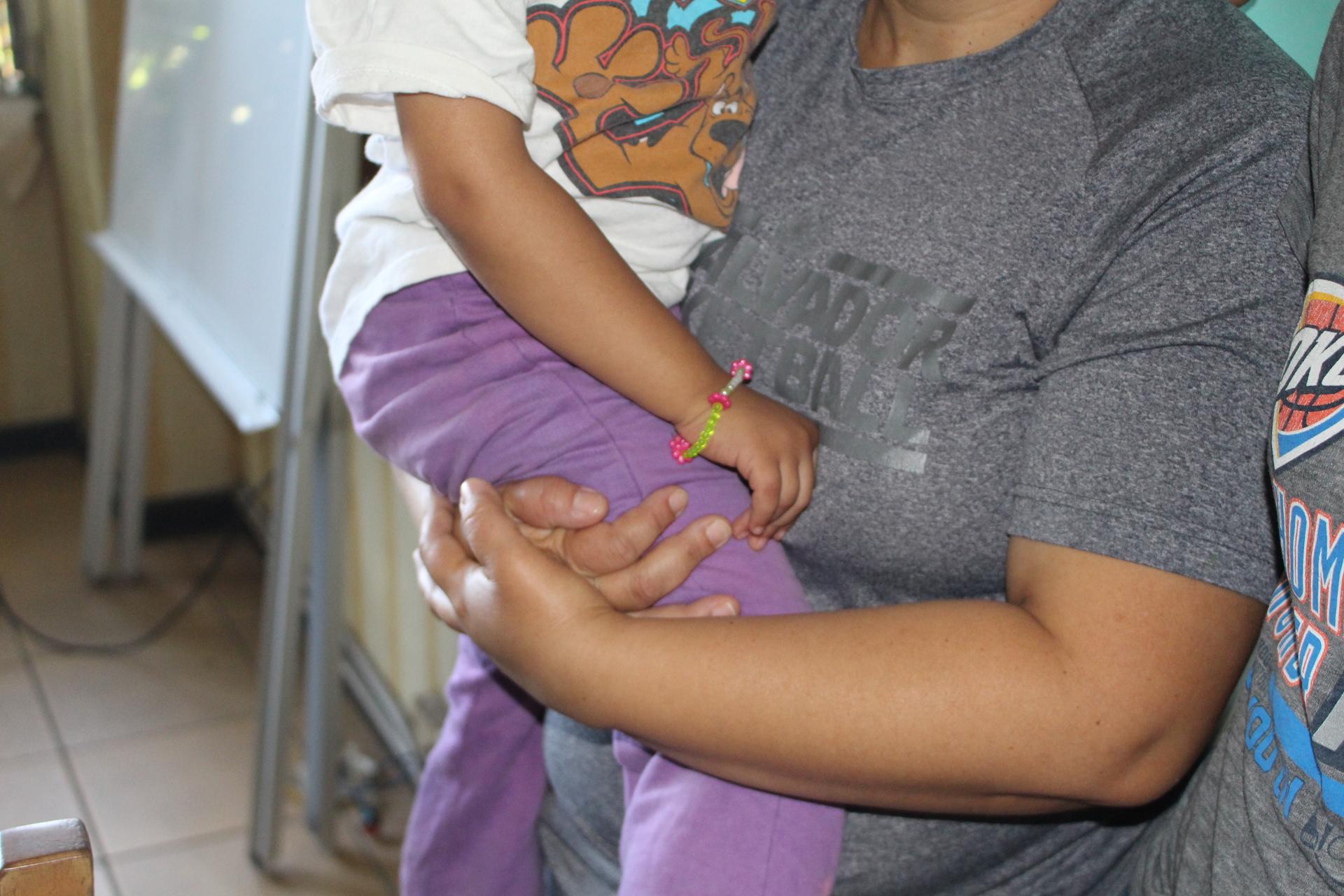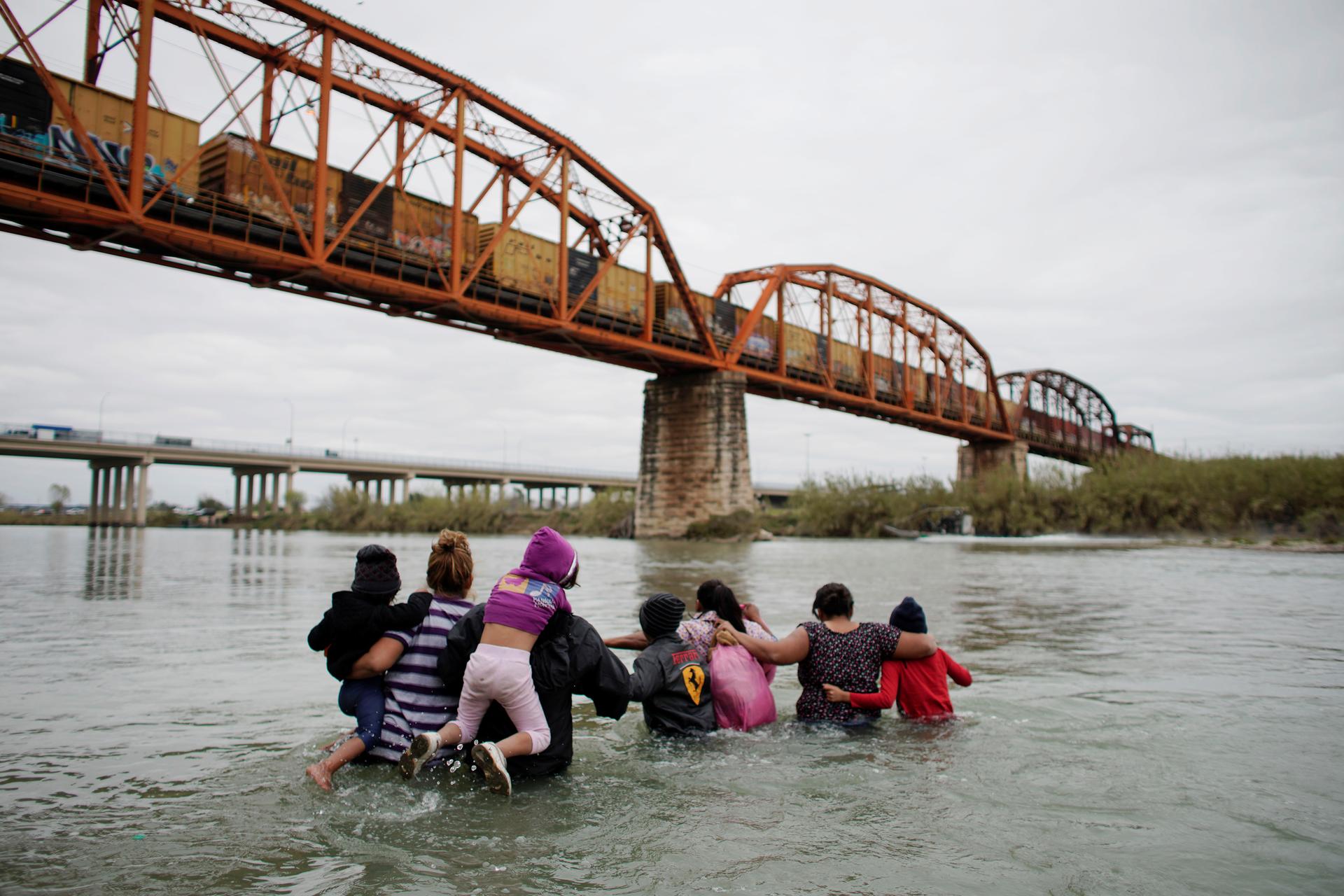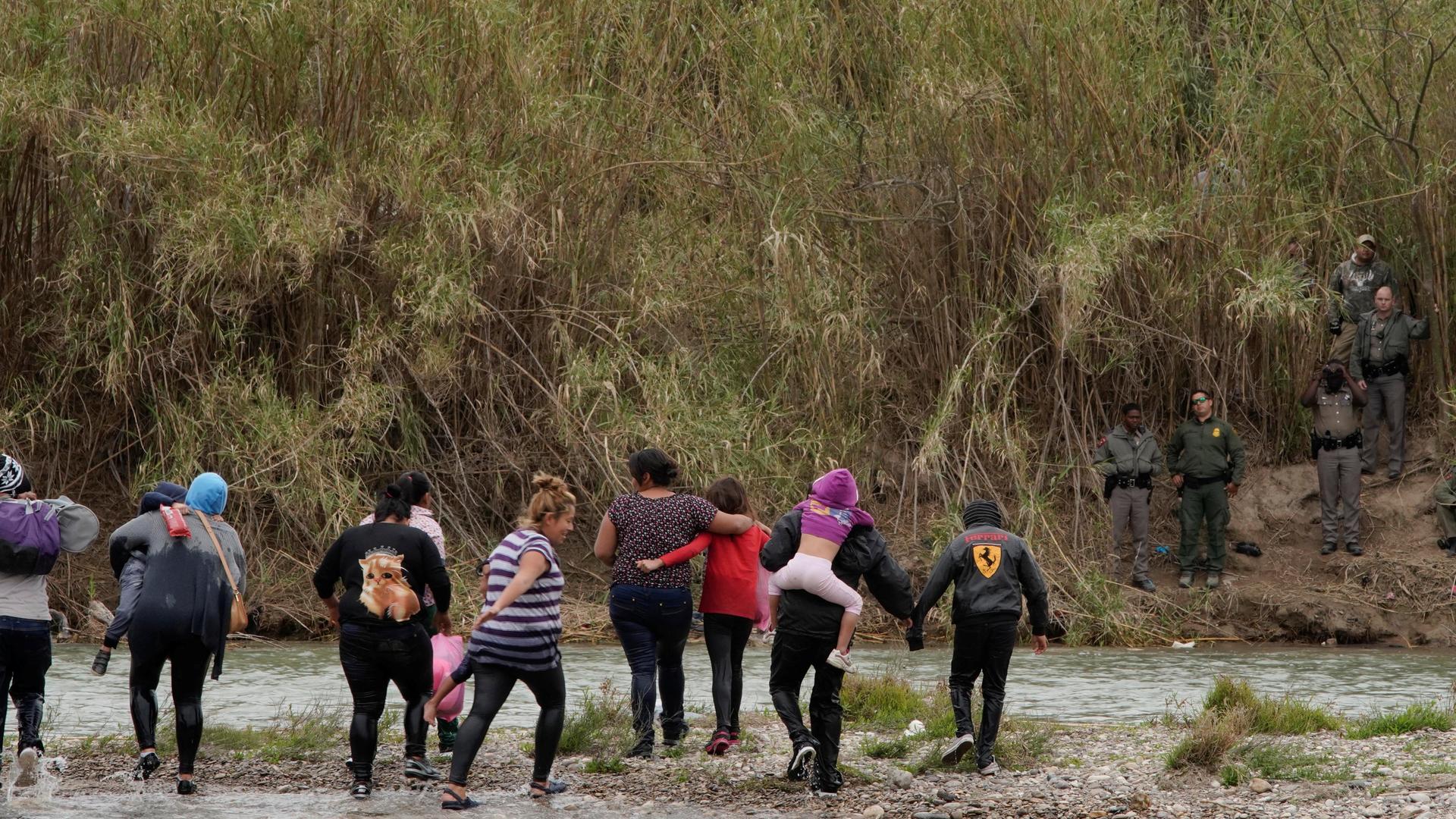Some Salvadoran migrants look to other nations for refuge as US tightens border
Migrants from El Salvador cross the Rio Bravo toward the United States, watched by US border patrol agents, as seen from Piedras Negras, Mexico, Feb. 19, 2019.
About three years ago, Camila began receiving calls from gang members demanding an extortion payment to “protect” the family’s business, a bakery in downtown San Salvador.
“That’s when we started to feel the fear, and more fear and more fear and more,” said Camila, whose name has been changed because she fears retaliation for speaking out. The threats intensified after her uncle refused to pay another, separate extortion payment. She believes she was followed by gang members while driving and narrowly escaped being murdered on multiple occasions.
“In El Salvador, we had everything — a business — but it was all taken away.”

Camila reported the crime but never saw justice. So, she decided to flee with her husband, father and two daughters, now 4 and 12, to Costa Rica, some 600 miles from El Salvador and where she believed the family would find relative peace. They arrived in April 2016 and struggled to start over after being uprooted from their lives. “In El Salvador, we had everything — a business — but it was all taken away,” Camila said.
Unlike the millions of Salvadorans who have migrated north to the US since the 1980s, Camila and her family looked south for refuge. Costa Rica is among a handful of countries, along with Panama, Spain, Italy, Mexico and Canada, receiving an increasing number of asylum applications from El Salvador since 2014. In 2017, an estimated 10,000 Salvadorans sought asylum in countries besides the US, according to data from the United Nations Refugee Agency.
Meanwhile, the number of Salvadorans coming to the southern US border declined in the past two years, even as migration for humanitarian reasons from other Central American countries — namely Honduras and Guatemala — has surged. In fiscal year 2018, the number of Salvadorans apprehended by Border Patrol decreased 37 percent from the year before to less than 32,000, according to Customs and Border Protection statistics shared with PRI’s The World.
Related: Fewer Salvadorans are being apprehended at the border
In recent months, overall border apprehensions have reached their highest monthly averages in a decade. But CBP statistics show that even though Salvadoran migration to the US is newly on the rise again, it lags far behind migration from Guatemala and Honduras. More than 118,000 families from those two countries were apprehended from October 2018 to February 2019, compared to just under 12,000 from El Salvador during that period.
The US has contributed to development and violence prevention in El Salvador, providing nearly $46 million in 2018, including $7.2 million for crime and violence prevention projects. The effectiveness of those projects in stemming migration is unclear. President Donald Trump has repeatedly threatened to cut this funding if governments fail to stop the flow of migrants. Still, on Wednesday, DHS Secretary Kirstjen Nielsen traveled to Honduras, where she signed a “compact” with Northern Triangle countries to promote their cooperation with US law enforcement on combatting human trafficking, smuggling and border security.
Deterrence along the route
For some Salvadorans, the promise of the “American Dream” has been tainted by coordinated deterrence efforts by Mexico and the United States. Trump administration policies have restricted access to asylum, particularly for Central Americans, which means that even if Salvadorans reach the US border, there are no asylum guarantees.
The number or arrivals has always fluctuated. In fiscal year 2014, more than 66,000 Salvadorans were apprehended at the US southern border — nearly double from the year before — fleeing a deteriorating security situation compounded by issues of unemployment and inequality. Weak institutions and corruption also contribute to a culture of impunity in El Salvador.
Lately, the journey through Mexico has gotten more dangerous as cartels and criminal groups have targeted Central American migrants for kidnapping and extortion. In 2014, the Mexican government rolled out its own “Southern Border Plan” with funding from the US to stem migration. They deployed more security forces to assist with migration enforcement and establish more order at the southern Mexican border, according to the Mexican government. But the plan only pushed migrants to more remote and dangerous routes and led to human rights abuses carried out by Mexican authorities, according to the Washington Office on Latin America.

Since 2016, the Trump administration has limited the number of people who can seek asylum at the southern US border each day, a process called metering in which asylum-seekers wait in Mexico for their turn to request asylum at a port of entry, sometimes for months. The recently rolled out “Remain in Mexico” policy, officially known as the Migrant Protection Protocols, means asylum-seekers who have finally gotten their turn to ask for asylum must return to Mexico, where they often feel unsafe because of high crime rates and cartel violence — which Trump himself has emphasized in many speeches. In fiscal year 2018, a record-high 65 percent of overall asylum claims were denied.
Related: The kids aren’t alright — when being young is a crime in El Salvador
‘Invisible’ migration
Many Salvadorans are now considering migrating to other countries, said Julio Buendia from Caritas, a nonprofit organization linked to the Catholic church that provides legal assessments of potential asylum cases in El Salvador.
For Camila, where she and her family ended up wasn’t as important as being able to leave. El Salvador’s main gangs, MS-13 and Barrio 18, were born on the streets of Los Angeles, California, and then grew in Central America as its members were deported from the US in the 1990s. Now, the gangs use extortion, sexual violence and retaliation killings to exert control over entire communities in El Salvador.
“The gang members there [in El Salvador] are vengeful. If you do something to them, they search for you until they achieve their objective: to do away with the person who made a fool of them. … Coming to Costa Rica was the most feasible option.”
“The gang members there [in El Salvador] are vengeful. If you do something to them, they search for you until they achieve their objective: to do away with the person who made a fool of them,” Camila said. “Coming to Costa Rica was the most feasible option.”
Gloria, another Salvadoran woman who arrived in Costa Rica in December 2018 to seek asylum, chose the country for its reputation as a more stable and secure place but also considered cultural factors such as language.
“In El Salvador, you hear a lot of positive things about Costa Rica,” said Gloria, whose name has been changed because her asylum case is still pending. “To us, it seems like a very well-developed and peaceful country, where you have more opportunities to better yourself than in El Salvador.”
Gloria also cited a support network of Salvadoran and Costa Rican friends who influenced her decision to seek asylum there.
Asylum-seekers like Gloria and Camila are part of an “invisible” form of migration, said Buendia.
“This migration has been driven by the same insecurity, violence and shortage of work, and upon seeing that they can’t get a visa to go to the US, they then decide to go to Spain [or another country].”
“This migration has been driven by the same insecurity, violence and shortage of work, and upon seeing that they can’t get a visa to go to the US, they then decide to go to Spain [or another country],” he added. In February, El Salvador elected a President Nayib Bukele of center-right party GANA. The 37-year-old former mayor has promised to tackle these problems, but some worry he may not have the experience or the political will to do so.
Related: Nayib Bukele: El Salvador’s young social media star — and next president
However, experts working with migrants in El Salvador say a decrease in the number of them being apprehended in the US does not necessarily mean the El Salvador’s situation has improved — or that fewer Salvadorans are leaving. They’re just going elsewhere.
For at least a decade, El Salvador has had one of the highest murder rates in the world. In 2018, more than 3,300 homicides occurred in a country of roughly 6.5 million people — an exorbitantly high murder rate even though homicides have nearly halved since 2015, when the country had one of its most murderous years on record. The country’s minister of justice and security has credited violence prevention programs and rehabilitation measures inside prisons for the decrease in homicides, but critics question whether there is enough evidence to make a direct correlation between these programs and homicide reduction.
“There is an insecurity problem and insecurity provokes homicides. But if we look deeper at the issue of insecurity we are going to find that a series of factors influence the decision to migrate.”
“We shouldn’t limit the issue of violence to homicides,” said Cesar Rios, director of the Salvadoran Institute of Migration, a local nongovernmental organization that runs programs for Salvadoran deportees and Salvadorans at risk of migrating. “There is an insecurity problem, and insecurity provokes homicides. But if we look deeper at the issue of insecurity, we are going to find that a series of factors influence the decision to migrate.” Among those factors are unemployment, a weak economy, and impunity for serious crimes, none of which have improved significantly in recent years, he said.
Salvadorans continue to flee the violence and insecurity in the country and asylum-seekers still need legal protections. In many cases, the US is no longer the best option.
“This is not about deciding where to go on vacation. This is a situation of risk and imminent danger.”
“This is not about deciding where to go on vacation. This is a situation of risk and imminent danger,” said Arnau Baulenas, a lawyer at the San Salvador-based Institute for Human Rights at the University of Central America. “So we work within the network that we have, to find the country where they can find the most favorable solution.”
US ‘not on the list’ of refuge
Camila expressed gratitude toward Costa Rica for welcoming her family when they were in danger. However, she said the country is “not prepared” to integrate migrants in the long term. Despite work permits, she and her husband have struggled to find permanent jobs. Instead, her husband works informally selling bread and pastries on the street. With just two countries separating her from El Salvador, she has yet to find peace.
So she is searching for refuge once again, this time by sending letters to embassies requesting the chance to seek asylum. She has delivered letters to the embassies of six countries — Canada, Switzerland, Finland, Italy, Australia and Norway — with only one response from Australia about the potential of opening up a new asylum case.
The US, however, is not on the list of potential places of refuge for Camila and her family. Camila feels the US has turned its back on the migrants and asylum-seekers who need help, contrary to its reputation as a “nation of immigrants.”
“The difference is that the US embassy is a little more distrustful,” Camila said. “Seeing the situation and how many people have gone, and the caravans, it’s much less likely they’re going to pay attention to me.”
